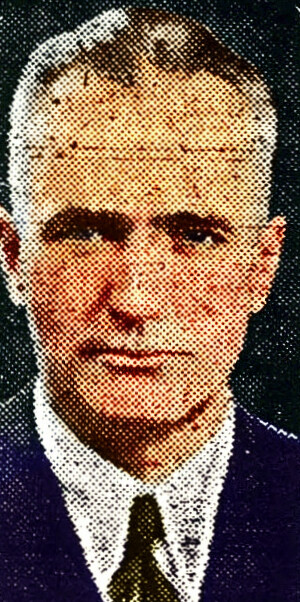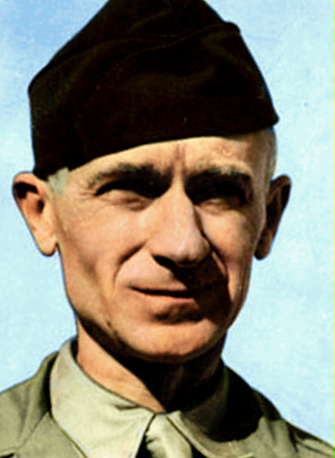Railroad car shortage due to blizzards
Train schedules to reflect bad weather
By S. Burton Heath
…
Delivery setup still complicated
…
Walworth Company plant walkout continued
…
Mother calls it ‘the most horrible, inhuman, brutal act in the world’
…

By Maj. Al Williams
Iwo Jima is an island a little more than four miles long, two miles wide at its widest point, and roughly the shape of South America. Its terrain is generally sand dunes, with no elevation over 554 feet.
American naval task forces swamped the Jap airpower on Iwo in a matter of hours. Complete dominance of the air over this fiercely contested patch of sand was ours. Yet our Marine losses have been far out of proportion to those of any previous engagement, and Marine Gen. Holland Smith says this struggle is the fiercest and toughest in the history of the Corps.
American naval task forces carriers, battleships, cruisers, destroyers and supply vessels are free to steam all around this tiny island without interference from the enemy. Yet the hand-to-hand fight continues and the cleanup job is still being done by infantrymen (Marines), aided and covered by air and naval forces as occasions permit and indicate.
The word “why” grows bigger day by day. Why must such a grim job be done by ground forces? Is it not apparent that this Iwo Jima situation shows a gap in either the machinery or tactics, or both, of modern warfare?
Isn’t there some other way to completely reduce an enemy position of such diminutive size other than men running forward, crouching, firing small arms, ducking into holes in the ground, hurling grenades, and using all the ground weapons of ground warfare?
As the score stands, this bloody fight on Iwo Jima mistakenly may be interpreted as a direct challenge to airpower. Haven’t we any new tricks? No “firsts” for us, instead of imitations of strategy and tactics invented by others? Does it definitely mark a critical limitation of airpower? Isn’t this just the sort of spot airpower should be able to render completely uninhabitable?
Of course, we don’t know all that actually is being done. But in the wake of the news that we have lost between 5,000 and 6,000 gallant Marines comes the question, “Can’t we find any other way – and where is airpower?”
Two miles by four miles – an island. The enemy force is composed of land forces only, and no adequate cover. Are we using all the available carrier planes for the continuous bombing of this sand spit? Have we dozens of barges or scows laden with trench mortars and small howitzers sending rolling barrages across these sand dunes?
If bombs and machine gun fire can’t do the trick, isn’t there any other expedient – any other than having our boys march and crawl to finish each Jap after the century-old fashion of pikemen?
What about gasoline and phosphorous combinations? Materials mean nothing to us. Lives mean everything.
Surely there must be ingenious American minds that can find some way to drench that dirty little sand island with some kind of inflammable liquid dropped from the air and burn the thing to a crisp.
As the Iwo Jima score stands today, it is a square challenge to airpower – or to the ingenuity of those who possess it.
Troops forced to experiment and improvise – German lines are invaded for materials
By Tom Wolf
…
Brainy college girl planning both learns by experience
By Ruth Millett
…
Padded hipline also shown
By Judy Barden, North American Newspaper Alliance
…
By Joe Williams
…
Boys are scattered through agencies under variety of unrevealing titles
By Ned Brooks, Scripps-Howard staff writer
…

By Ernie Pyle
IN THE WESTERN PACIFIC (delayed) – Now I’ve had my first experience as a saltwater doughboy. I’ll try to tell you about it in a few thousand well-chosen paragraphs.
This series will be about life aboard an airplane carrier. My carrier was part of that first strike on the Tokyo area, and we helped out at Iwo Jima, too.
We’ll start right at the beginning, and within the limits of naval security, I’ll try to tell you what living on an aircraft carrier is like, and how a big task force works when it goes out after the enemy.
First, we boarded a plane and flew for a long time, and landed on a tiny coral island, white and glaring im the tropic sun. Tall slanting palm trees waved their green fronds from their topknots.
The island was framed in a wide circle of bright green water. And that was bordered by a thin line of snow-white surf, where the rolling waves beat themselves to a froth over the submerged reef at the edge of the water. And on beyond that, everywhere as far as the eye could see, was the heavy dark blue of the deep, deep ocean.
And out there on that dark blue water, lay the United States Fleet. Hundreds and hundreds of ships. The Navy says officially that it was the greatest concentration of fighting ships ever assembled in the history of the world. It was something to take your breath away.
The world’s mightiest
True, I have seen bigger fleets. Both in our invasions of Sicily and Normandy we had more ships. But they were not predominantly warships. Mainly they were landing craft and troop-carrying vessels.
But these here were fighting ships – the world’s mightiest. Battleships and cruisers and carriers and uncountable destroyers. And all of the swarm of escorts and tugs and oilers and repair ships that go with them.
And this wasn’t the only fleet. Others started from other anchorages scattered out over the Pacific, hundreds and thousands of miles from us. They started on a time-table schedule, so that they would all converge in the Upper Pacific at the same time.
If you had felt lonely and afraid in anticipation of the ordeal upon which you were setting out, it disappeared when you made yourself a cell in this mighty armada.
Plenty of company
For when we bore down upon the waters of Japan and Iwo Jima, we were nearly a thousand ships and we were beyond a half a million men!
Whatever happened to you, you would sure have a hell of a lot of company.
A small fast motorboat, its forepart covered with canvas like a prairie schooner, took me from the island to the carrier to which I had been assigned. It was a long way out, and we were half an hour bobbing up and down through the spray.
Ships were so thick we had to weave in and out around them. The water was speckled with small boats running from ship to ship, and back and forth to the island. The weather was hot, and sometimes you stood up and took the spray, because it felt good.
I had asked to be put on a small carrier, rather than a big one. The reasons were many. For one thing, the large ones are so immense and carry such a huge crew that it would be like living in the Grand Central Station. I felt I could get the “feel” of a carrier more quickly, could become more intimately a member of the family, if I were to go on a smaller one.
Also, the smaller carriers have had very little credit and almost no glory, and I’ve always had a sort of yen for poor little ships that have been neglected.
And also again (although this of course had nothing to do with my choice, of course, of course) there was an old wives’ superstition to the effect that the Japs always went for the big carriers first, and ignored the little ones.
Further investigation revealed this to be pure fiction, but what you don’t know at the time doesn’t hurt you, and I didn’t know this at the time. So gaily I climbed aboard my new home – curious, but admittedly uneager for my first taste of naval warfare in the Pacific.
Who was this one man army?
Damn… the government rewards him in the worst way possible. I hope he soon takes the medication required alleviate the extra gas problem.
Strike ? That French collaboration is sure working off pretty dandy.